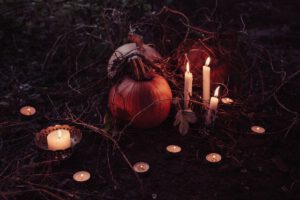
Photo by William Warby, courtesy of Flickr
FRIDAY, OCTOBER 31 and SATURDAY, NOVEMBER 1 and SUNDAY, NOVEMBER 2—From Samhain to Mexico’s Day of the Dead to Halloween, world cultures celebrate the belief that at this time of year, the veil between this world and the next is particularly thin—and ancestors are held close. Don’t worry, it’s not all solemn and bone-chilling, though—today’s secular Halloween also brings out bright Jack-o-lanterns, loads of candy and a pretty good excuse for adults to join in on the fun with kids. So grab your best ghoulish mask and get the (Halloween) party started!
THE COVID-19 HALLOWEEN FORECAST
Like most publicly celebrated holidays in 2020, the pandemic has dramatically changed the way Halloween will be celebrated this year. Here are a few headlines:
BUSINESSES ARE SHIVERING THIS YEAR! On October 1, MarketWatch carried one of many business reports predicting a downturn on the commercial side of the holiday under a headline: Halloween sales forecast could be frightful Tony Garcia reported, in part: “More than half, 52%, of consumers say they will buy less candy this year. And 73% expect to celebrate Halloween differently.”
BUT, WHO KNOWS? 148 MILLION STILL WILL CELEBRATE. On October 14, Kimberly Amadeo reported in The Balance that the magnitude of 2020 celebrations is changing dramatically—so retail sales may not tell the whole story. Millions still are planning to celebrate and some may wind up with even more elaborate plans, as a result.
 A SWEET REPORT FROM CONFECTIONERS. Of course, the National Confectioners Association has a vested interest in a sweet forecast and, in September, did report via PR Newswire that chocolate and candy sales appeared to be rising.
A SWEET REPORT FROM CONFECTIONERS. Of course, the National Confectioners Association has a vested interest in a sweet forecast and, in September, did report via PR Newswire that chocolate and candy sales appeared to be rising.
DAWN OF ‘THE CANDY CHUTE’ Americans are known for their innovations! Reports nationwide are describing various models of “candy chutes” so homeowners can still deliver candy to kids from a safe distance either up on a porch—or even from an upstairs window! We’ve heard of these chutes made from common pieces of rain gutters—like the one that members of Clarkston United Methodist Church in Michigan built so they could continue to offer free holiday treats to their town’s children this year. Here’s a Detroit News story about a chute made from PVC pipe. Here’s an NPR story that mentions chutes made from cardboard tubes.
Maybe Halloween 2020 will be remembered for years as the dawn of the “candy chute”!
HAVE YOU SEEN A CANDY CHUTE?
HALLOWEEN: A CHRISTIAN ORIGIN; A CULTURAL PHENOMENON
Allhallowtide, the triduum of Halloween, recalls deceased spirits, saints (hallows) and martyrs alike, in one collective commemoration. The word Halloween is of Christian origin, and many Christians visit graveyards during this time to pray and place flowers and candles at the graves of their deceased loved ones. The two days following All Hallows Eve—All Saints’ Day and All Souls’ Day—pay homage to the souls that Christians believe are now with God. In medieval England, Christians went “souling” on Halloween, begging for soul cakes in exchange for prayers in local churches.
Halloween’s secular side has emerged during the past century, and today, trick-or-treating, carving pumpkins, visiting haunted houses, watching horror movies and dressing up like favored characters has become custom in Western culture. Recent estimates are that the very diverse American business of “haunted attractions” brings in hundreds of millions of dollars each year, and the commercial elements of Halloween have spread from North America to Europe, South America, Australia, Japan and parts of East Asia.
SAMHAIN: GUISING FOR A TRICK
The original Samhain marked the end of the harvest season and ushered in winter, or the “darker half” of the year, in Gaelic Ireland, Scotland and the Isle of Man. During this time of year, bonfires were lit for the purpose of divination and as a protective and cleansing measure. Legend has it that spirits could easily come to earth, and many people would leave out food and drink for the roaming entities.
In many households, ancestors were welcomed to the table with particular enthusiasm, and large meals were prepared. Multiple sites in Ireland were, and still are, associated with Samhain, and the spirits that emerge there at this time of year. Guising—donning a costume—was thought to “trick” ill-intentioned spirits roaming the streets near Samhain, and hallowed-out turnips were lit with a candle and placed in windows, their monstrous carved faces frightening bad spirits.
Today’s Samhain emerged as part of the late 19th century Celtic Revival, and Neopagans, Celtic Reconstructionist Pagans and Wiccans all celebrate the holiday, in slightly varying ways. Most keep the widespread traditions of lighting bonfires, paying homage to ancestors, welcoming the “darker” season and preparing feasts with apples, nuts, meats, seasonal vegetables and mulled wines.
MUERTOS: DAY OF THE DEAD
Vibrant decorations for Dia de los Muertos, or Day of the Dead, mark towns in Mexico and Latin American communities far and wide, as the lives of the departed are celebrated with vigor. The full festival of Dia de los Muertos typically lasts two or three days (in some regions, customs begin on October 31), and traditionally, November 1 pays tribute to the souls of children and the innocent while November 2 is dedicated to deceased adult souls. In Mexico, relatives adorn altars and graves with elaborate garlands and wreaths, crosses made of flowers and special foods. Families gather in cemeteries, where pastors bestow prayers upon the dead. For children, Dia de los Muertos celebrations mean candy like sugar skulls and once-a-year treats; music and dancing delight celebrants of all ages.
ALL THINGS HALLOWEEN:
DIY COSTUMES, DÉCOR, PARTIES & MORE
What’s Halloween without some good costumes and tasty treats?
- DIY costumes: If buying a premade costume isn’t your idea of creative fun, get do-it-yourself ideas from Martha Stewart, Real Simple and DIY Network.
- Recipes: Find the perfect Halloween-themed dish, with ideas from Food Network, Taste of Home, Epicurious and Rachael Ray.
- Just for kids: Get kids in on the act with printables and more from Parents, Martha Stewart and Disney.


Tell Us What You Think